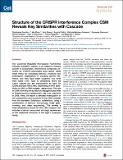Files in this item
Structure of the CRISPR Interference complex CSM reveals key similarities with Cascade
Item metadata
| dc.contributor.author | Rouillon, Christophe | |
| dc.contributor.author | Zhou, Min | |
| dc.contributor.author | Zhang, Jing | |
| dc.contributor.author | Argyris, Politis | |
| dc.contributor.author | Beilsten-Edmands, Victoria | |
| dc.contributor.author | Cannone, Guiseppe | |
| dc.contributor.author | Graham, Shirley | |
| dc.contributor.author | Robinson, Carol | |
| dc.contributor.author | Spagnolo, Laura | |
| dc.contributor.author | White, Malcolm F | |
| dc.date.accessioned | 2014-04-04T16:01:01Z | |
| dc.date.available | 2014-04-04T16:01:01Z | |
| dc.date.issued | 2013-10-10 | |
| dc.identifier | 73771592 | |
| dc.identifier | bfafb896-cf33-4d22-acd6-0b28d3604604 | |
| dc.identifier | 000326195800012 | |
| dc.identifier | 84885336337 | |
| dc.identifier | 000326195800012 | |
| dc.identifier.citation | Rouillon , C , Zhou , M , Zhang , J , Argyris , P , Beilsten-Edmands , V , Cannone , G , Graham , S , Robinson , C , Spagnolo , L & White , M F 2013 , ' Structure of the CRISPR Interference complex CSM reveals key similarities with Cascade ' , Molecular Cell , vol. 52 , no. 1 , pp. 124-134 . https://doi.org/10.1016/j.molcel.2013.08.020 | en |
| dc.identifier.issn | 1097-2765 | |
| dc.identifier.other | ORCID: /0000-0003-1543-9342/work/47136075 | |
| dc.identifier.uri | https://hdl.handle.net/10023/4556 | |
| dc.description.abstract | The Clustered Regularly Interspaced Palindromic Repeats (CRISPR) system is an adaptive immune system in prokaryotes. Interference complexes encoded by CRISPR-associated (cas) genes utilize small RNAs for homology-directed detection and subsequent degradation of invading genetic elements, and they have been classified into three main types (I–III). Type III complexes share the Cas10 subunit but are subclassifed as type IIIA (CSM) and type IIIB (CMR), depending on their specificity for DNA or RNA targets, respectively. The role of CSM in limiting the spread of conjugative plasmids in Staphylococcus epidermidis was first described in 2008. Here, we report a detailed investigation of the composition and structure of the CSM complex from the archaeon Sulfolobus solfataricus, using a combination of electron microscopy, mass spectrometry, and deep sequencing. This reveals a three-dimensional model for the CSM complex that includes a helical component strikingly reminiscent of the backbone structure of the type I (Cascade) family. | |
| dc.format.extent | 11 | |
| dc.format.extent | 1992711 | |
| dc.language.iso | eng | |
| dc.relation.ispartof | Molecular Cell | en |
| dc.subject | Clustered Regularly Interspaced Palindromic Repeats (CRISPR) system | en |
| dc.subject | Immune system | en |
| dc.subject | Prokaryotes | en |
| dc.subject | CSM complex | en |
| dc.subject | Sulfolobus solfataricus | en |
| dc.subject | Cascade complex | en |
| dc.subject | Methylation | en |
| dc.subject | Acetylation | en |
| dc.subject | Phosphorylation | en |
| dc.title | Structure of the CRISPR Interference complex CSM reveals key similarities with Cascade | en |
| dc.type | Journal article | en |
| dc.contributor.sponsor | BBSRC | en |
| dc.contributor.sponsor | BBSRC | en |
| dc.contributor.institution | University of St Andrews. School of Biology | en |
| dc.contributor.institution | University of St Andrews. Biomedical Sciences Research Complex | en |
| dc.identifier.doi | 10.1016/j.molcel.2013.08.020 | |
| dc.description.status | Peer reviewed | en |
| dc.identifier.grantnumber | BB/K000314/1 | en |
| dc.identifier.grantnumber | BB/J005665/1 | en |
This item appears in the following Collection(s)
Items in the St Andrews Research Repository are protected by copyright, with all rights reserved, unless otherwise indicated.

